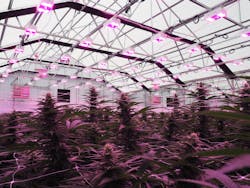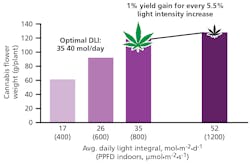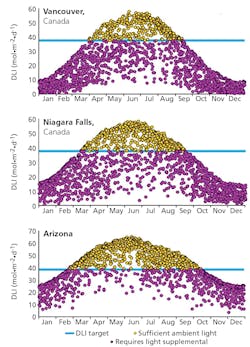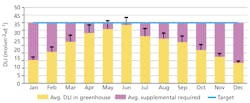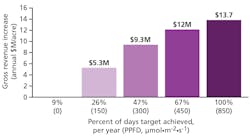Marijuana greenhouses are an ideal business to capitalize on the “greenrush.” Most commonly referred to as cannabis by industry professionals, this cultivar is possibly more valuable than any greenhouse crop in the history of agriculture. Cannabis is worth 100 times more per unit area than other high-value greenhouse crops. As LumiGrow CEO Jay Albere presented at the 2019 HortiCann Light + Tech conference, making comparisons to cucumbers, peppers, and tomatoes, each of those crops is valued at less than $100 gross revenue per square meter per year, whereas cannabis is valued at $12,900 gross revenue.
However, to achieve such financial heights, a grow operation must be built upon proper understanding of the supplemental lighting needs in the greenhouse environment (Fig. 1). In this article, we’ll walk through a real-world cannabis greenhouse scenario and show how a greenhouse in a high-light region can still gain an additional $13.7M (million) per acre per year in revenue.
How does light impact yields?
The greenhouse method is generally preferred because, let’s face it, sunlight is free. As mentioned, cannabis is a demanding crop with high light needs. Growers can’t afford to lose on yields, but it is also important to know how much yield will be gained by adding supplemental light. Let’s look at how far more light will go in a cannabis greenhouse.
The cost to light an acre of greenhouse space at an average supplemental intensity (or PPFD — photosynthetic photon flux density) of 400 μmol·m-2·s-1 is a little under $1M. This may seem like a high cost, yet each additional light fixture a grower provides is like a revenue engine — which can pay itself off in just the first year by increasing flower yields.
At optimal light levels, greenhouse cannabis flower is worth approximately $39M annually per acre. It’s important to note that any light quantity below a daily light integral (DLI) of 40 mol·m-2·d-1 reduces this value. The DLI is a measure of photosynthetically active radiation (PAR) received each day as a function of light intensity and duration.
Horticulturalists generally follow a 1% rule: For most crops, 1% more light means 1% more yield. Cannabis too typically follows this classic rule of thumb; however, there is a point of saturation where the rate of increasing yield diminishes.
Lighting at 52 mol·m-2·d-1, as Justice did, ensures that yields will stay stable long into the future. This is due to the light loss effect, also known as lumen depreciation, or most recently in horticulture as the yield loss factor.
So for growers with greater capital and a long-term business plan, providing 52 mol·m-2·d-1 can make financial sense. For growers that are just getting started, 40 mol·m-2·d-1 will provide adequate return on their investment.
Cannabis case study
Now that we understand just how much optimizing light quantity will increase yields, let’s compare the supplemental light needs in Arizona; Vancouver, Canada; and Niagara Falls, Canada.
LumiGrow modeled five years of NASA solar irradiance data and determined the number of days that required supplemental light to reach a 40 mol·m-2·d-1 DLI target in these different locations. We found that even outdoors, at the locations listed above, growers would need additional light for the following number of days to reach their target (Fig. 3):
- 283 days of supplemental light (Vancouver)
- 262 days of supplemental light (Niagara Falls)
- 181 days of supplemental light (Arizona)
In Fig. 3, all the yellow dots represent days that deliver enough sunlight outside of a greenhouse to hit yield targets. But the graphs do not account for light obstruction from a greenhouse. There are several greenhouse factors that reduce the light crops receive, including:
- Glazing transmission rates (varies from 92% for single-pane glass to 76% for double polyethylene film; glazing will have environmental soils as well)
- Trusses and struts
- Thermal curtains
- Fans
- Light fixtures
- Other infrastructure that produces shadows
The grower might consider the equipment cost savings as well as electricity savings and choose not to provide supplemental light to cannabis flowering bays. However, this is not necessarily the most financially sound plan when we consider the average solar light levels and the demands of the cannabis crop.
Looking at Fig. 4, we can see the monthly average solar light levels within the greenhouse. Even in June, the grower would need 1 mol of supplemental light on average to push total light levels to the 40 mol·m-2·d-1 optimum. When it comes to winter months (November through February), the Arizona greenhouse will require an average of 23 mol·m-2·d-1 in supplemental light. Without supplemental light, the grower would only achieve the 40 DLI target on 9% of days (33 days) each year.
Worse yet, this means missing the DLI target by an average of 35% and, because of the 1% rule, forfeiting nearly $14M of potential revenue per acre each year. It’s clear that supplemental light is not an option but a necessity.
How much light does the greenhouse need?
To keep from losing $14M per acre in revenue, a cannabis grower might decide to purchase LED fixtures to supplement light in the greenhouse. But how much supplemental light is necessary?
An intensity of 150 μmol·m-2·s-1 would increase the days the crop achieves the 40 DLI target to 26%, 300 μmol·m-2·s-1 to 47%, and 450 μmol·m-2·s-1 to 67%. To achieve the 40 DLI target on all days would require 870 μmol·m-2·s-1. This is a decision growers must make carefully to find a perfect balance between increased yields and capital expenses.
As the grow operation achieves the 40 mol DLI target on more and more days, the farmer will also increase annual gross revenue (Fig. 5). With just 150 μmol·m-2·s-1 of supplemental light, revenue increases by $5.3M.
This increase continues with greater supplemental intensities with a maximum gain of $13.7M up to the 40 mol DLI target every day of the year. (Keep in mind that gains well above $13.7M are easily possible when lighting above a 40 mol DLI target). Note that just a 50 μmol·m-2·s-1 intensity increase means at least a million dollars of greater net revenue per acre up to an intensity of 600 μmol·m-2·s-1.
There is an economic threshold at which adding more light does not increase net revenue. At this point, the quantity of light requires a large number of fixtures, so many fixtures that the capital expense exceeds the value of increased yield. In the Arizona example, this economic threshold is 750 μmol·m-2·s-1. This means that the best ROI will be found around 500–550 μmol·m-2·s-1. Other lower-light regions will have a significantly higher threshold.
Revisiting the economics
As we have established, cannabis is likely the most valuable crop on a per-acre basis. This means very small yield improvements can greatly increase revenue. Even in sunny Arizona, for each day a grower supplements solar light to achieve 40 mol·m-2·s-1, they will on average increase gross revenue by ≈$41,000. This adds up to a revenue increase of $13.7M per acre per year.
In lower-light regions, this light-to-revenue effect will be much more dramatic. To ensure these revenue increases are realized, cannabis growers must only use reliable supplemental lighting sources that are proven to grow commercial cannabis, they must supply adequate CO2, and they should optimize all environmental variables for LEDs.
As our global climate changes, efficiency has become more and more important both to sustain the planet and maximize a grower’s net revenue. Inefficient — and insufficient — lighting will compromise crop quality and growers’ fiscal sustainability. It’s time to roll up our sleeves and provide the perfect light to maximize cannabis crop yields. After all, there really is a lot of green on the line.
Editor’s note: This article was edited with permission from an original grower’s guide by LumiGrow.
LUMIGROW is a smart horticultural lighting company that designs and manufactures a range of proven grow light solutions.
*Updated Mar. 3, 2020 4:50 PM to include additional author credit.
